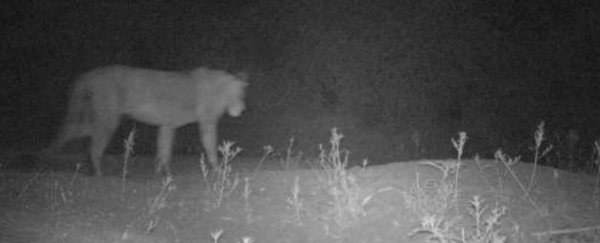Researchers have discovered evidence of at least 100 - and possibly as many as 200 - lions living in a remote region of north-west Ethiopia. The newly spotted population appears to be stable, which means it's a happy day for conservationists who have the rare chance to expand, rather than shrink, the dwindling species range for once.
"During my professional career I have had to revise the lion distribution map many times," expedition leader Hans Bauer from the University of Oxford, told New Scientist. "I have deleted one population after the other. This is the first and probably the last time that I'm putting a new one up there."
The Alatash National Park on the border of Ethiopia and Sudan had long been considered a potential habitat for lions, but given how remote it is, no one had ever seen any real evidence of the species.
As part of an expedition funded by the Born Free Foundation, Bauer set out to investigate whether lions really could be living in the area, and could have gone unnoticed all these years.
Ironically, the evidence was a whole lot easier to find than he imagined - on his way to setting up camera traps on one of his first days on the job, he spotted lion tracks. "That was the 'Eureka' moment when I was sure that there really are lions," he said.
On the second night of filming, he finally got his visual proof, when night-vision cameras captured a female lion roaming around the river bed.
The discovery is even more exciting given the position of the park, which is right next to an even bigger national park on the Sudan side of the border. Lions are currently assumed to be extinct in Sudan, but Bauer thinks there could be up to 200 individuals living between the two parks.
"Considering the relative ease with which lion signs were observed, it is likely that they are resident throughout Alatash and Dinder," he explained.
His team came up with the population estimate by calculating the available surface water in the two parks, prey density (which is pretty low), and the average range that each lion needs.
"On a total surface area of about 10,000 km2 [about 4,000 square miles], this would mean a population of 100 to 200 lions for the entire ecosystem, of which 27 to 54 would be in Alatash," said Bauer.
The news couldn't come at a better time - with just 20,000 lions left in the wild across Africa, and populations predicted to halve in 20 years. The US has recently added the species to the endangered list in order to discourage hunters from targeting the animals - like in the tragic case of Cecil.
But this newly found population, hidden away in the remote Alatash National Park, might be better off than those living close to human development. And now that scientists are aware of it, they'll be able to better protect it.
"The situation is fairly positive," Bauer told New Scientist. "I think the fact that the Ethiopian government recently made it a national park is a giant leap forward. Now we have to support them in improving park management, but I think they're taking it very seriously."
